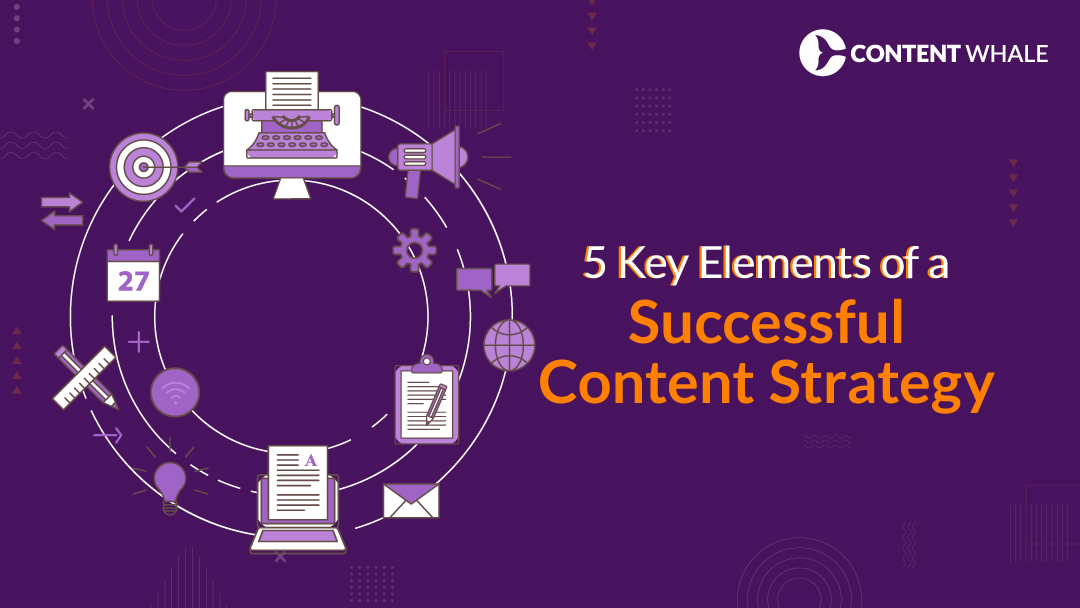Quick Summary
Explore the elements of a successful content strategy to understand how each component contributes to your overall plan. Learn practical tips for implementing these content strategy key elements effectively. Discover how you can boost your brand’s visibility and engagement with a well-rounded approach. Plus, find out how Content Whale can support you in building a successful content strategy tailored to your business needs.
A well-defined content strategy is vital in digital marketing today. Without it, businesses often face inconsistent messaging, poor audience engagement, and missed growth opportunities.
A structured approach to content helps in overcoming these challenges by aligning efforts with business goals and ensuring all content resonates with the target audience.
This blog highlights the five key elements of a successful content strategy and provides practical tips for each component. It enables you to build an effective strategy that drives results.
1. Clear Objectives and Goals
Setting clear objectives and goals is fundamental to a successful content strategy. These goals align your content efforts with business objectives, ensuring each piece of content serves a clear purpose.
Objectives should be specific, measurable, achievable, relevant, and time-bound (SMART). For example, aim to “increase organic website traffic by 20% within the next six months” rather than a vague “increase traffic”.
Aligning Objectives with Business Goals
Aligning content objectives with business goals is essential. If the goal is brand awareness, create engaging blog posts and social media campaigns. For lead generation, develop valuable resources like e-books or webinars to capture contact information.
Examples of Clear Objectives
- Increase Website Traffic: Boost organic traffic by 20% in three months.
- Improve Conversion Rates: Enhance conversion rates by 15% over the next quarter.
- Grow Email Subscriber List: Expand your list by 500 new contacts in six months.
- Boost Social Media Engagement: Increase engagement by 30% within three months.
Implementing and Measuring Objectives
Use a detailed content plan and track progress with KPIs like website traffic and social media engagement. Tools like Google Analytics and HubSpot provide valuable insights to measure and optimize your strategy continuously.
2. Audience Research and Persona Development
Understanding your target audience is essential for a successful content strategy. Thorough audience research and well-crafted personas enable you to create content that truly resonates with your audience.
Importance of Audience Research
Audience research involves gathering data about your potential customers, including demographics (age, gender, location), psychographics (interests, values), and behaviors (purchasing habits, content preferences). Tools like Google Analytics and social media insights are invaluable for this process.
Creating Buyer Personas
Buyer personas are semi-fictional representations of your ideal customers. Each persona includes:
- Demographics: Age, gender, income, education level.
- Background: Goals, challenges, and pain points.
- Behavior: Content preferences, social media habits.
For example, a persona for a fitness brand might be “Fitness Fiona,” a 30-year-old professional who prefers quick workout videos and health blogs.
Benefits of Personas
Using personas helps tailor your content strategy to meet specific customer needs, improving marketing effectiveness. Personalized content strategies can increase engagement, as users feel understood and valued. This approach also streamlines marketing efforts, saving time and resources by focusing on high-potential audience segments.
Implementing Personas in Content Strategy
- Segmentation: Divide your audience based on personas for precise content targeting.
- Content Mapping: Align content with the stages of the buyer’s journey for each persona.
- Personalized Messaging: Customize tone, style, and formats to resonate with each persona.
- Optimization: Use KPIs to track performance and refine your strategy.
By integrating detailed personas into your content strategy, you ensure your content is relevant and engaging, driving better results.
3. Content Planning and Editorial Calendar
Having a well-organized content plan and editorial calendar is essential for a successful content strategy. These tools help ensure consistency, streamline processes, and improve content quality and effectiveness.
Importance of Content Planning
A content plan outlines what content needs to be created, when it should be published, and who is responsible for each task. This planning stage is crucial for aligning content with your overall strategy and ensuring all content serves a specific purpose. It helps in setting clear goals and keeping track of progress.
Benefits of an Editorial Calendar
An editorial calendar is a visual workflow that helps schedule content creation and publication. Here are some key benefits:
- Improves Consistency: Planning content in advance ensures a steady flow of content, which keeps your audience engaged.
- Enhances Quality: By separating ideation and creation phases, an editorial calendar allows more focus on producing high-quality content.
- Supports Accountability: It helps team members stay on track with their responsibilities, improving overall efficiency.
- Streamlines Processes: Simplifies content creation and publication processes, making it easier for different teams to collaborate effectively.
- Enables Innovation: Provides a clear overview of content, allowing room for creative and innovative ideas.
Key Components of an Editorial Calendar
An effective editorial calendar should include:
- Content Types: Specify whether the content is a blog post, video, infographic, etc.
- Publish Dates: Schedule when each piece of content will be published.
- Content Status: Track progress from ideation to publication.
- Keywords: Optimize content for specific search terms.
- Distribution Channels: List platforms where the content will be shared.
Tools for Creating an Editorial Calendar
Several tools can help manage your editorial calendar effectively:
- Google Calendar: Useful for scheduling and accessible from any device.
- Google Sheets: Great for tracking progress and collaboration.
- Trello: Ideal for larger teams needing more detailed project management.
Implementing a well-structured content plan and editorial calendar can significantly enhance your content strategy, leading to better engagement and higher quality output.
4. High-Quality and Relevant Content

Creating high-quality and relevant content is a vital component of a successful content strategy. This element ensures your content resonates with your audience and meets their needs, thereby building trust and authority in your industry.
Importance of High-Quality Content
High-quality content is crucial for engaging and retaining your audience. It reflects the expertise, authoritativeness, and trustworthiness (E-A-T) that search engines like Google prioritize. Content that is well-researched, accurate, and valuable not only improves user experience but also enhances your site’s SEO performance, leading to higher rankings in search engine results.
Ensuring Content Relevance
Relevant content addresses the specific needs and interests of your target audience. To ensure relevance, conduct thorough audience research to understand their pain points, preferences, and behaviors. Utilize tools like Google Analytics and social media insights to gather data on what type of content your audience engages with the most.
Best Practices for Creating High-Quality Content
- Research and Accuracy: Ensure all content is thoroughly researched and fact-checked. Accurate information builds credibility and trust.
- SEO Optimization: Use relevant keywords naturally throughout your content to improve search engine visibility. Include internal and external links to provide additional value and context.
- Engaging Formats: Diversify content formats to include blog posts, videos, infographics, and interactive content. Different formats cater to varying audience preferences, enhancing engagement.
- Originality: Avoid duplicate content. Original insights and unique perspectives can set your content apart from competitors.
- User Experience: Ensure your content is easy to read and navigate. Use clear headings, bullet points, and visuals to break up text and make it more digestible.
Tips for Maintaining Content Quality
- Regular Audits: Conduct content audits to assess and update existing content, ensuring it remains relevant and accurate.
- Feedback Loop: Use analytics and audience feedback to improve content quality and relevance continuously.
- Expert Contributions: Involve subject matter experts in content creation to provide authoritative insights and increase content credibility.
By focusing on high-quality and relevant content, you not only enhance user engagement but also strengthen your brand’s authority and trustworthiness, key elements of a successful content strategy.
5. Performance Measurement and Analytics
Measuring the performance of your content is an essential component of a successful content strategy. This process involves analyzing various metrics to understand how your content is performing and identifying areas for improvement. Here’s why it’s important and how to implement it effectively.
Importance of Performance Measurement
Performance measurement allows you to track the effectiveness of your content strategy. By analyzing data, you can determine what works and what doesn’t, helping you make informed decisions to optimize your content efforts. This continuous improvement cycle is key to maintaining a successful content strategy.
Key Metrics to Track
To measure content performance, focus on several key metrics:
- Traffic: Monitor the number of visitors to your content. Tools like Google Analytics can help track these figures.
- Engagement: Analyze how users interact with your content. Look at metrics such as time spent on page, social shares, comments, and likes.
- Conversions: Track actions that indicate a successful content interaction, such as form submissions, downloads, or purchases.
- SEO Performance: Use tools like SEMrush to monitor keyword rankings and organic search traffic. Check metrics like bounce rate and backlinks to understand your content’s SEO impact.
Tools for Analyzing Content Performance
Several tools can help you gather and analyze performance data:
- Google Analytics: Provides comprehensive insights into website traffic and user behavior.
- SEMrush: Offers detailed SEO analytics, including keyword tracking and backlink analysis.
- Content Performance Tools: Platforms like HubSpot and Bitly provide content-specific analytics, helping you understand engagement and effectiveness across different channels.
Using Analytics to Refine Your Strategy
Analytics not only help you understand past performance but also guide future content creation. By identifying high-performing content, you can replicate successful strategies. Conversely, pinpointing underperforming content allows you to revise or replace ineffective tactics. Regularly updating your content strategy based on these insights ensures it remains aligned with audience preferences and market trends.
Integrating performance measurement and analytics into your content strategy ensures you continuously improve and stay relevant, which are essential content strategy key elements for long-term success.

To summarize, incorporating the key elements of a successful content strategy is vital for achieving your marketing goals. Each component plays a significant role in ensuring that your content strategy is both effective and sustainable.
- Clear Objectives and Goals: Setting specific, measurable, achievable, relevant, and time-bound (SMART) goals helps align your content efforts with your business objectives, ensuring that every piece of content serves a purpose.
- Audience Research and Persona Development: Understanding your audience through detailed research and developing accurate buyer personas allows you to create content that resonates with your target market. This step is essential for tailoring your content to meet the specific needs and preferences of different audience segments.
- Content Planning and Editorial Calendar: An organized content plan and editorial calendar help maintain consistency and streamline your content creation process. Tools like Google Calendar, Trello, and Asana can assist in managing your schedule effectively.
- High-Quality and Relevant Content: Producing high-quality content that is relevant and valuable to your audience builds trust and authority. Focus on thorough research, originality, and user-friendly formats to keep your content engaging and informative.
- Performance Measurement and Analytics: Regularly analyzing your content’s performance using tools like Google Analytics and SEMrush allows you to make data-driven decisions. Tracking key metrics such as traffic, engagement, and conversions helps refine your content strategy for better results.
By integrating these content strategy key elements into your approach, you can create a robust and effective content strategy that drives engagement, builds authority, and achieves your business objectives. Keep adapting and optimizing your strategy based on performance data to stay relevant and successful in the dynamic digital marketing environment.
FAQs
What are the key elements of a successful content strategy?
The key elements of a successful content strategy include setting clear objectives and goals, conducting thorough audience research and persona development, maintaining a detailed content plan and editorial calendar, creating high-quality and relevant content, and continuously measuring performance and analytics. These content strategy components help ensure your content aligns with your business goals and resonates with your audience.
Why is audience research important for a content strategy?
Audience research is critical because it provides insights into the preferences, behaviors, and needs of your target audience. By understanding your audience, you can tailor your content to address their specific pain points and interests, leading to higher engagement and better results. This research helps in creating detailed buyer personas, which are essential content strategy key elements.
How can an editorial calendar improve my content planning?
An editorial calendar helps in organizing and scheduling your content creation and publication. It ensures consistency, improves team collaboration, and helps you plan content around key dates and events. Tools like Google Calendar, Trello, and Asana can be used to manage your editorial calendar effectively, making it a crucial part of your successful content strategy.
What are some tips for creating high-quality content?
To create high-quality content, focus on thorough research, originality, and relevance. Ensure your content is well-structured, engaging, and valuable to your audience. Use SEO best practices to optimize your content for search engines. Diversify your content formats to include blog posts, videos, infographics, and interactive content. Regularly update and audit your content to maintain its quality and relevance.
How do I measure the success of my content strategy?
Measuring the success of your content strategy involves tracking key performance indicators (KPIs) such as website traffic, engagement rates, conversion rates, and SEO performance. Tools like Google Analytics and SEMrush provide valuable insights into how your content is performing. Regular analysis helps refine your strategy and ensure it remains effective and aligned with your business goals.





